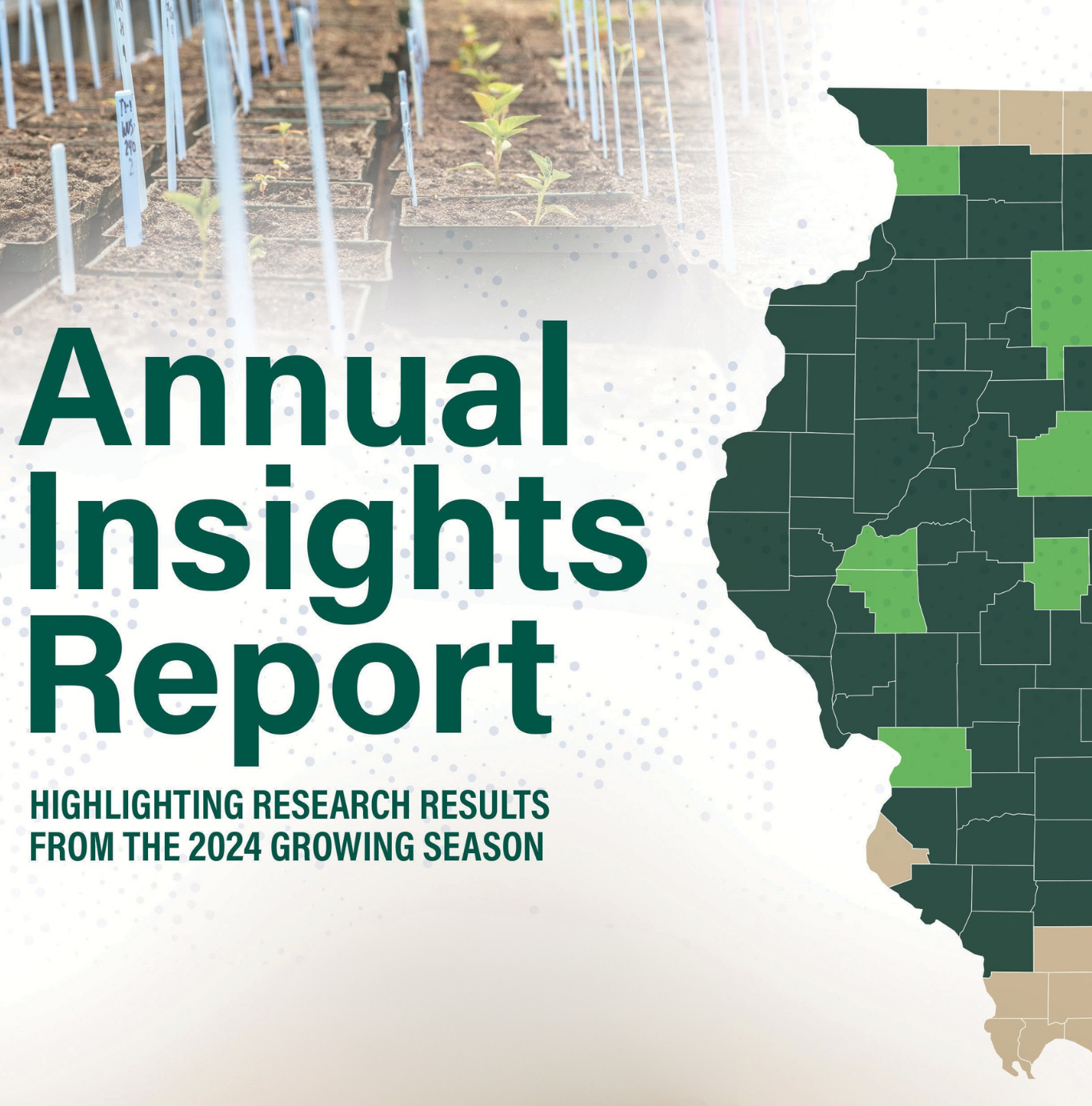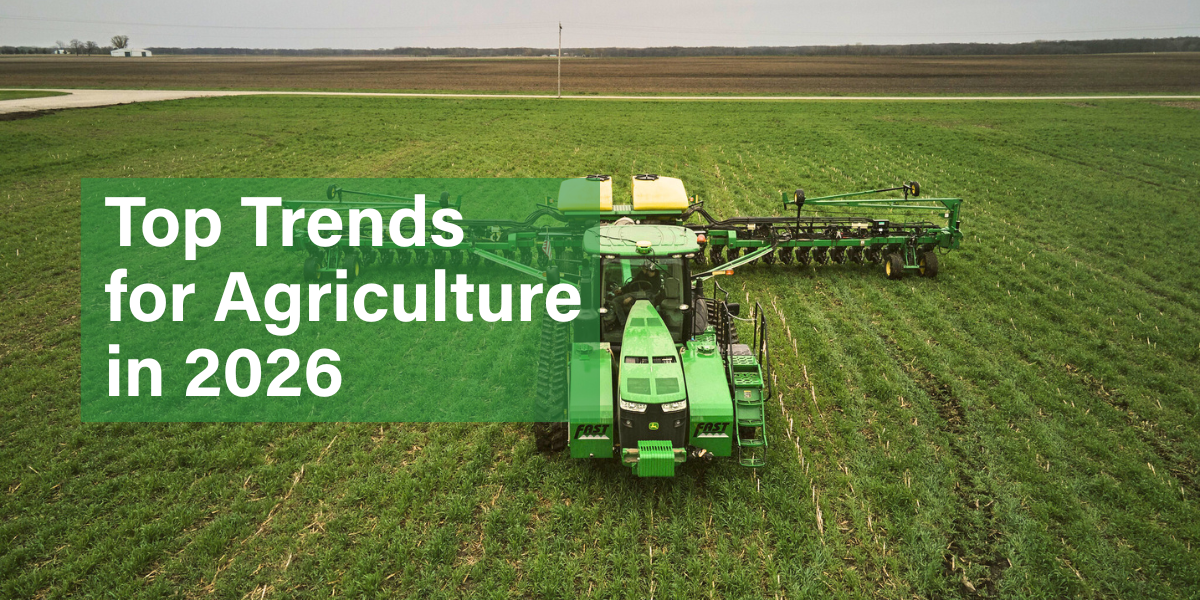Bringing Research into the Hands of Farmers
By Abigail Peterson, CCA, Director of Agronomy, Illinois Soybean Association
The Soybean Production board committee is responsible for cross-functional agronomic research and education that creates opportunities for Illinois soybean farmers to increase on-farm profitability and manage crop production risks. These final reports, generated from Illinois Soybean Association (ISA) checkoff-funded research, were all voted on by Illinois soybean farmers. Our farmers are asking deliberate agronomic questions to strengthen our state’s production efforts. Non-biased, science-based research has been summarized within this publication for farmers to evaluate what applications could make a difference within their operations. The ISA Agronomy team is expanding efforts across the state through educational resources and technical assistance to build a solid agronomic foundation for the No. 1 soybean-producing state. As partners that augment this agronomic research, universities play a vital role in helping farmers unpack (or understand) these complex and expansive issues. Bridging the gap between the data and farmer adaptation, the ISA On-Farm Trial Network (OFTN) is available for farmers to participate in driving research across the state with field-scale metrics. Better applied research can optimize checkoff-funded studies. Seasonal variability will challenge study results and provide answers to questions we don’t even know yet. Having actionable protocols and the flexibility to adjust to farmers’ needs makes the OFTN a necessary program within ISA’s Soybean Production strategy. With the research results from the 2024 season and continued summaries on FieldAdvisor.org, we want farmers to ask questions, challenge the system and engage with the ISA agronomy efforts for better production research, data and education in Illinois.
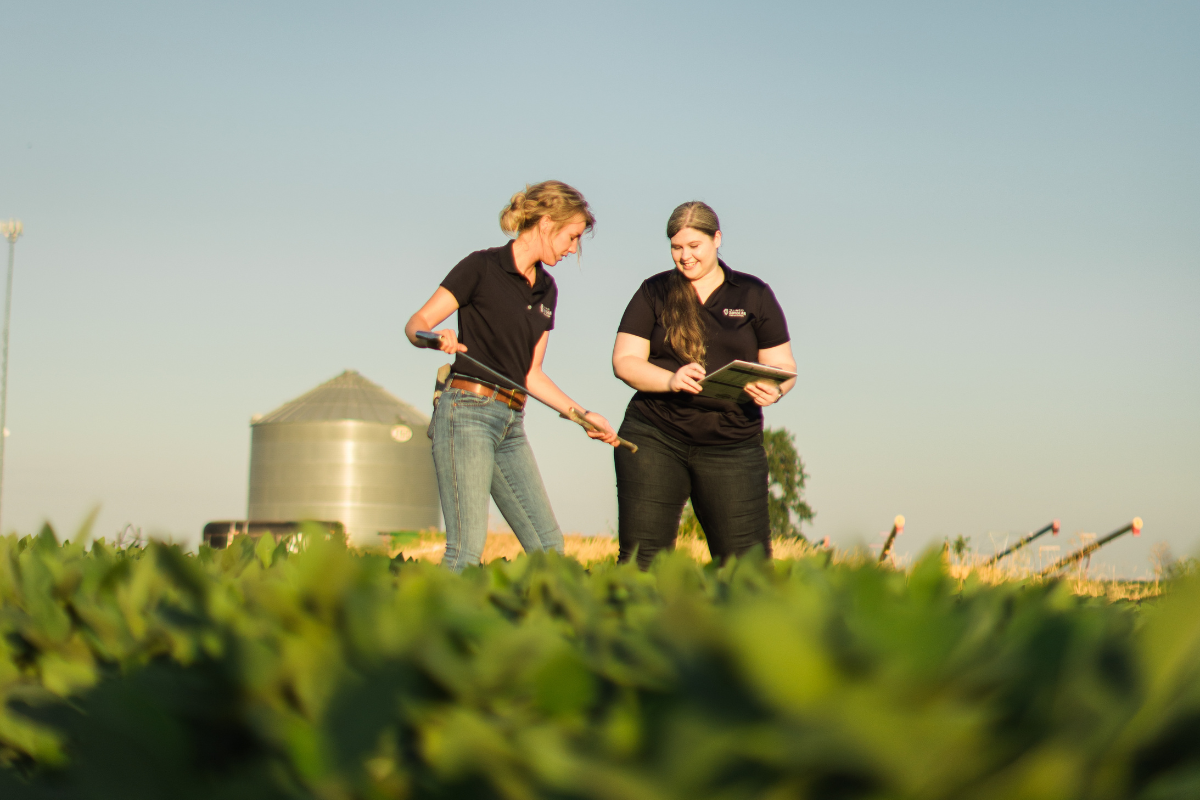
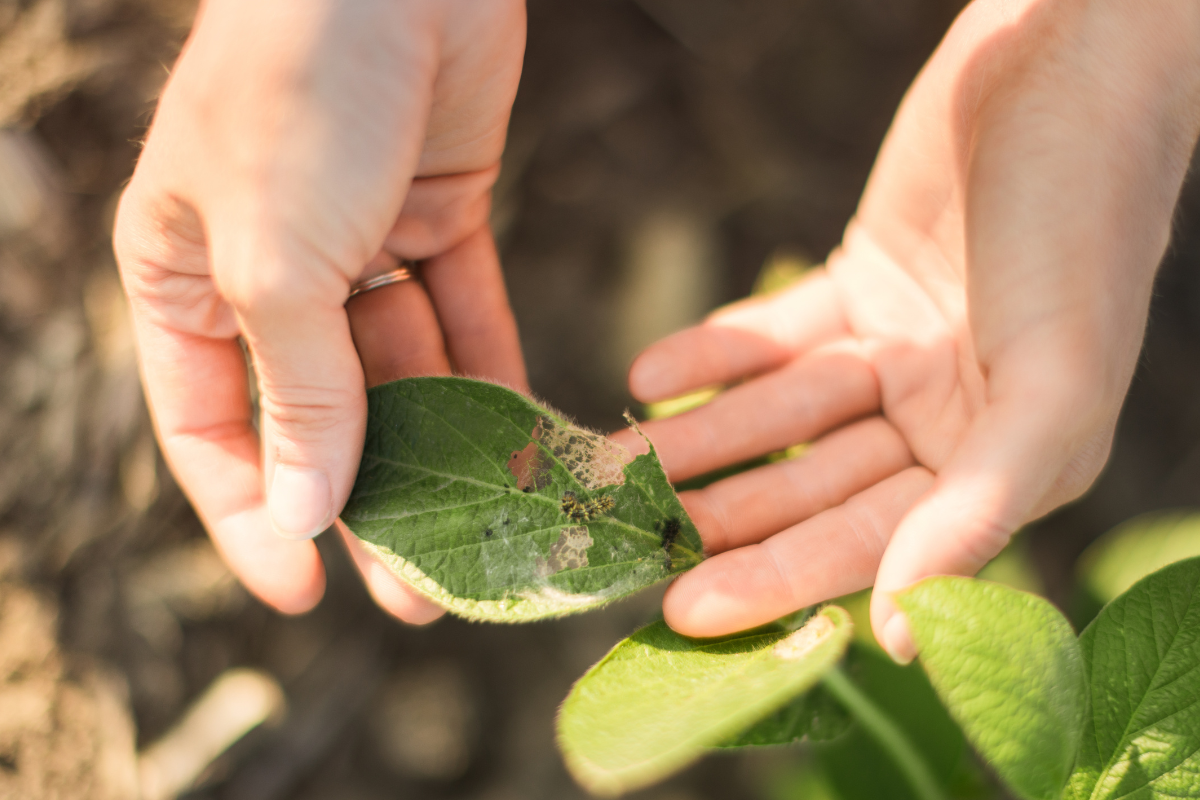
Can soybean yields be increased with direct fertilizer applications?
Project Leaders: Dan Schaefer, Illinois Fertilizer and Chemical Association; Jason Solberg, Illinois Fertilizer and Chemical Association; Eric Miller, Piatt County Farmer; Giovani Preza Fontes, University of Illinois
Purpose: In most corn-soybean rotations, fertilizer applications are typically made to maximize corn yields, with less consideration of their impact on soybean yields. This project tests how direct soybean fertilization affects yields and evaluates the potential return on investment compared to conventional soybean production.
Approach: On-farm trials in central Illinois were conducted in 2023 and 2024 to test yield response to controlled-release N, P, K and S fertilizers in a strip-till system. Products tested included controlled-release urea with a 140-day delay before release, along with potash, Mosaic Aspire, Mosaic MESZ and pelletized gypsum. The trials also compared 15” and 30” row spacings. The plot followed an omission-style layout to evaluate each fertilizer’s contribution to yield. The treatments in 2024 were modified to add more combinations as a result of 2023 yield results.
Results:
- Row spacing and fertilizer had little consistent impact on soybean yields.
- In the warm, dry spring of 2023, untreated 15” soybeans (95.4 bushels per acre) yielded highest compared to 30” regardless of fertilizer products (92.8-93.9 bushels per acre).
- In 2024, the lowest yields came from untreated 15” soybeans (72.9 bushels per acre), while the two highest yields were from 15” rows (77.3 bushels per acre) and 30” rows (77.1 bushels per acre). Both had all fertilizer products. These were closely followed by the untreated 30” rows (76.5 bushels per acre).
- In 2024, April and May were very wet and prevented timely planting. This impacted yields, emphasizing the importance of planting as early as possible (April 1 for central Illinois).
Key Takeaway: Use 15” rows and do not spend money for additional fertilizer if soil tests are in the recommended range for pH, P1 and K.
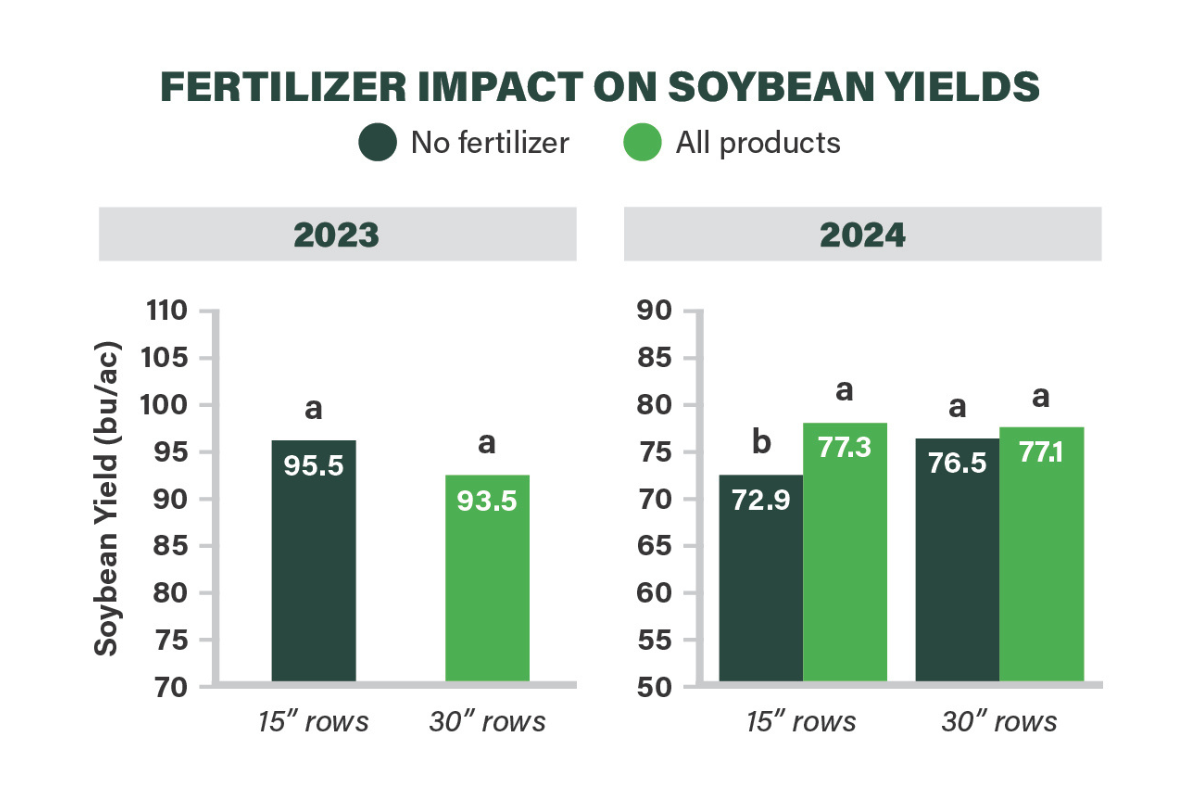
Soybeans grown in 15” rows without fertilizer in 2023 yielded 2 bushels per acre more than fertilized soybeans in 30” rows. However, in 2024, the lowest-yielding treatment was unfertilized soybeans grown in 15” rows. Treatments within a graph that share the same letter are not statistically different.
Growing an On-Farm Trial Network
By Stacy Zuber, Ph.D., Research Data Scientist, Illinois Soybean Association
A primary goal of the Illinois Soybean Association (ISA) Agronomy team is to deliver the best, most up-to-date information available to farmers growing soybeans in Illinois. A key facet of this effort is directly funding researchers around the state to investigate the most pressing issues and challenges facing growers
in today’s agricultural environment.
This Annual Insights Report highlights the results of many of those research projects conducted by exceptional university researchers in Illinois. Although we are proud of the research projects we have funded, we also recognize we face fundamental challenges in delivering the most relevant agronomic research: How can we ensure this research makes sense for Illinois soybean growers? Are we asking the right questions? And maybe even more importantly, can farmers use the results to make agronomic management decisions?
Within Illinois, there are amazing researchers producing vital information every year. These researchers come from both universities and industry. Yet both of these research channels have limitations in the results that they can deliver to farmers. University researchers are often limited to small-plot or greenhouse
research with limited ability or connections to test their results in real-world conditions and with full-scale equipment. Industry research, meanwhile, can bring tremendous breakthroughs, valuable data and guidance for agronomic management, but it can be limited to research focused on selling products and susceptible
to bias.
We wondered: Can the Illinois soybean checkoff help provide a complementary solution? We believe ISA is uniquely positioned to lead and facilitate unbiased, farmer-focused, field-scale research in partnership with university and industry researchers. Backed by farmers, our research priorities are guided annually
by farmer input, as I’ll share more later. To that end, we’ve started the On-Farm Trial Network (OFTN) funded by the ISA checkoff program. The objective of OFTN is to serve as a bridge between researchers at universities and in private industry to farmers out in the field. It enables collaboration among university and
industry researchers in on-farm settings, allowing us to provide a real-world check on the practicality and feasibility of guidance and recommendations.

The growing conditions and soils of Illinois deliver particularly productive environments for producing soybeans today. But our goal is to make sure it stays that way far into the future. Every year brings new challenges to farmers’ operations and bottom lines. To ensure our on-farm trials address the most important production issues, and answer the right agronomic questions, the ISA Agronomy team solicits farmer responses to the Soybean Production Concerns Survey each year to anonymously capture the needs and interests of Illinois soybean growers. These responses help steer the trials we sponsor in conjunction with other researchers working on similar avenues of interest.
One type of trial within OFTN is Action Trials. These flexible, replicated trials address relevant agronomic issues and provide actionable guidance on topics ranging from pest management to planting rates. An important goal of these trials is to deliver results and actionable guidance as soon as possible. For the 2025
growing season, we are facilitating two different Action Trials. One will focus on sulfur fertilization in soybeans, and another will explore return on investment of soybean insecticides.
The trials will compare soybean yields with and without 30 pounds of sulfur per acre, applied as either ammonium sulfate or ammonium thiosulfate. To help pinpoint the starting sulfur application rate, we spoke with Illinois researchers and crop consultants. We based our decision on research from around the
Midwest. Our goal is to better understand where a yield response to sulfur is possible before dialing into more specific recommendations in future years. We have 18 trial sites around the state to test this and are working with some amazing farmer cooperators.
The insecticide trials expand on a current ISA checkoff-funded project led by Dr. Nick Seiter at the University of Illinois. We worked with Dr. Seiter to develop a protocol testing the impact of foliar and seed-treatment insecticides under real-world conditions. Graduate students from Dr. Seiter’s lab will assist with insect counts and injury assessments throughout the growing season.
Another vital type of trial within OFTN is Legacy Trials. These long-term strip trials evaluate the impact of conservation practices such as cover crops and no-till on the soil. They also assess the long-term effects of those practices on management. Because changes to the soil can take many years to detect, these trials are set up to compare management practices for a minimum of five years. Many of the Legacy Trials are former Soil Health Partnership trial sites that farmers have been invested in for many years and are interested in continuing. We are excited to facilitate this opportunity for farmers and hope to expand these sites further throughout the state. One goal is to provide long-term cover crop and conservation sites for other researchers to help with the real-world challenges of adopting these practices.
Keep an eye out for results from these trials in the future! Much of the value of this research will come from the farmers who find new ways to utilize the results as they make ongoing agronomic management decisions. We are eager to share results from these on-farm trials in future issues of the Annual Insights Report, in-person at the Field Advisor Forum and field days, and online on FieldAdvisor.org through blogs, webinars and podcast episodes.
We also invite more farmers to sign up on fieldadvisor.org/on-farm-trial-network to learn more about future Action and Legacy trial opportunities through OFTN in 2026 and beyond.
How widespread is resistance to Group 15 herbicides in Illinois waterhemp populations?
Project Leaders: Aaron Hager and Travis Wilke, University of Illinois
Purpose: Group 15 herbicides are known for providing residual control of waterhemp, but this research helps to determine if that statement will hold true into the future. The research team is studying waterhemp populations across Illinois to determine if offspring already show notable resistance to Group 15 herbicides.
Approach: In fall 2023, waterhemp seed was collected from soybean fields across Illinois. Researchers screened the waterhemp populations in the greenhouse to determine which contained resistance. This process involves growing the plants after a preemergence application of a Group 15 herbicide (Dual II Magnum) at a discriminating dose – the amount of herbicide that controls a sensitive population, but not a known-resistant one (Figure 1). If a population shows the same or less control than the known-resistant population at the discriminating dose, it is moved to the next phase of research to confirm resistance (Figure 2). This research will conclude in 2025.
Results: Of the 45 populations evaluated to date, 20 (44%) will be advanced to the next level of screening. Control of several populations was exceptionally low, indicating a higher frequency of resistance compared with the known resistant population. These results suggest farmers need earlier postemergence herbicide applications since the length of soil residual control from Group 15 herbicides will be shorter where resistance occurs. This project also highlights the value of integrated weed management and using additional preemergent herbicides for waterhemp control.
This concept applies to all Group 15 herbicides, not just Dual II Magnum. Switching to a different Group 15 herbicide is not a viable solution. Farmers should evaluate fields where residual control from Group 15 herbicides is lacking. Scouting should focus on eliminating early “escapes.” Although the solution will vary by farm, the approach should not. Resistance to Group 15 herbicides is suspected to be significantly more widespread than earlier thought. These findings support the continued recommendation of a zero-tolerance mindset. Each field should be managed so that the length of residual control does not further decrease. This can be achieved by eliminating all surviving waterhemp and using integrated weed management practices to reduce selection pressure to herbicides.
Key Takeaway: Researchers found widespread resistance to Group 15 herbicides. Farmers need to have a zero-tolerance approach to escapes to prevent further loss of residual control.
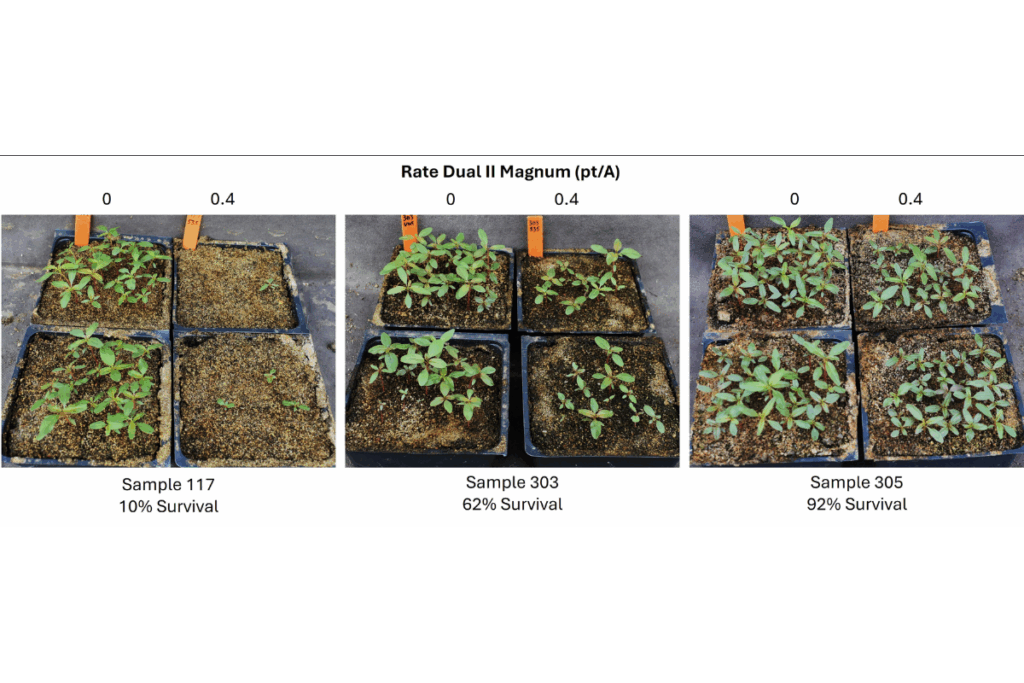
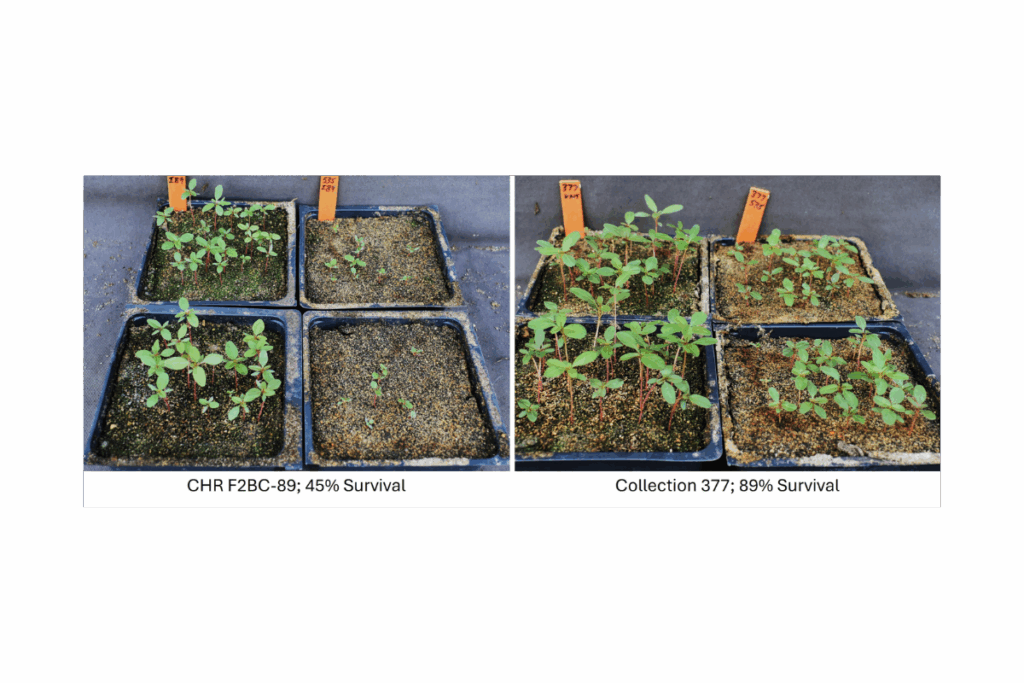
Figure 1 (Left) shows the responses of different waterhemp populations to application of Dual II Magnum compared to untreated population on the left of each photo. At the discriminating dose of 0.4 pt/A, populations have demonstrated great variability in control. Survival percentages are calculated based on live plants at 10 days after planting and herbicide application. Figure 2 (Right) shows a comparison with a confirmed herbicide-resistant (CHR) population. CHR F2BC-89 was provided by Isabel Werle in Dr. Tranel’s lab and was developed from one of the original populations with confirmed resistance to Group 15 herbicides. Although survivors are stunted, a survival rate of 45% was determined. Populations such as that of Collection 377 demonstrated this level of survival or greater and were moved to the next phase of research to confirm resistance. Photo Credit: Travis Wilke.
Illinois Soybean Cyst Nematode Survey Results
Project Leader: Nathan Schroeder, University of Illinois
Purpose: Soybean cyst nematode (SCN) is considered the most damaging soybean pathogen in the U.S. and is now found in every county in Illinois. SCN has been controlled using resistant soybean varieties. However, most of these varieties rely on a single genetic source (PI 88788), which has been continuously used for SCN control for decades. As expected, many SCN populations are adapting to PI 88788. It is impossible to know if an individual farmer’s SCN control strategies are effective without sampling for the pest. This survey allows farmers to assess their fields at a local level and make informed management decisions.
Approach: Illinois farmers and agronomists submitted free samples for SCN testing to the University of Illinois Plant Clinic. Farmers requested a kit with instructions on sampling best practices via email (freescntesting@illinois.edu). Samples with high egg counts (greater than 5,000 eggs per 100 cm3 of soil) were kept for an additional test, called an HG type test, to determine if that population has developed resistance. Find more information at FieldAdvisor.org/SCNtesting.
Results:
- As expected, SCN is widely distributed across the state (Figure 1).
- From the 1,017 samples received from September 2023 to August 2024, the average SCN population was 1,512 eggs per 100 cm3 of soil. Although this number suggests a moderate level of SCN infestation, the numbers varied tremendously across sites (Figure 2).
- Approximately 34% of samples had fewer than 100 eggs per 100 cm³. This suggests that while PI 88788 sources of resistance are still generally effective, some populations are becoming less responsive to PI 88788.
- A farmer with a relatively low SCN egg count (less than 1,000 eggs per 100 cm3 of soil) and in a regular rotation plan is likely experiencing minimal yield loss and can continue their current management approach. They should plan to test the same field in four to five years. In contrast, a farmer with a very high egg count (above 10,000 eggs per 100 cm3 of soil) should consider planting a non-host crop like corn during the upcoming year and test the field again after the non-host to make sure the population has decreased.
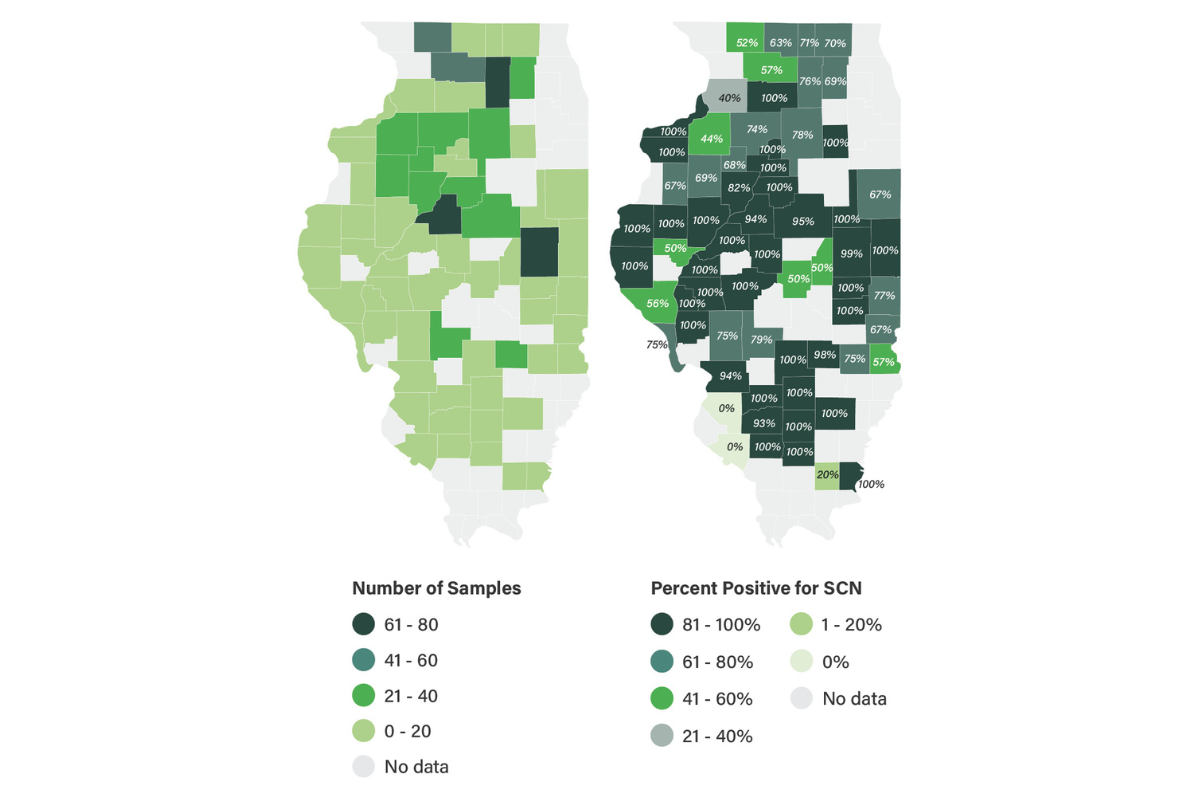
Figure 1
This figure shows the number of samples submitted for SCN testing from each county and the percentage of those samples that were positive for SCN as measured by the University of Illinois Plant Clinic. No data indicates no samples were received from that county.
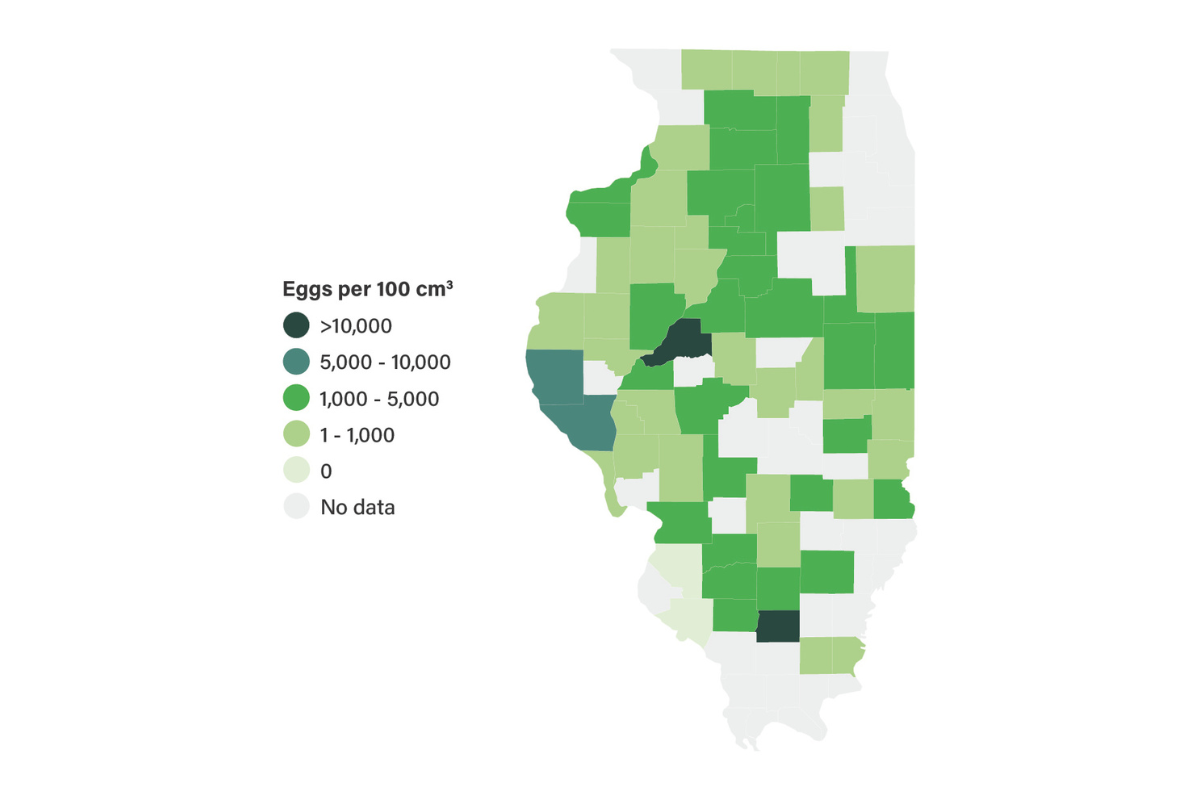
Figure 2
This figure shows the county average of SCN egg counts per 100 cm3 of soil from the samples submitted between September 2023 to August 2024.
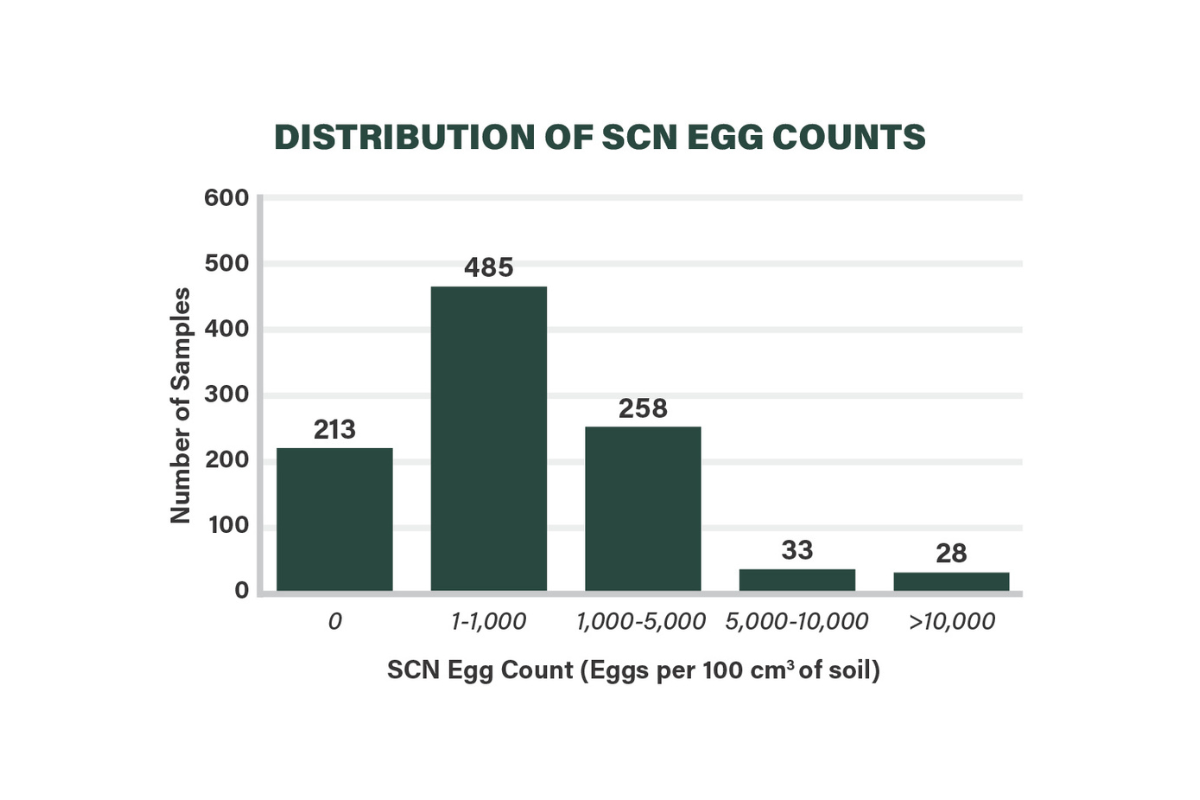
Figure 3
This figure shows how many samples submitted had various levels of SCN egg counts detected. Of the 1,017 samples submitted across the state, about 69% had 1,000 eggs per 100 cm3 or less.
Key Takeaway: Farmers should use their SCN egg counts to help guide their SCN management decisions.
In the Field and Informed: How the Field Advisor Crop Report Supports Illinois Soybean Farmers
By Kelsey Litchfield, Agronomy Outreach Manager, Illinois Soybean Association
“Keep one foot in the furrow” – this quote resonated with me recently while reading Orion Samuelson’s foreword for former Secretary of Ag John Block’s memoir, “Pigs, Politics, Persistence.” Orion attributes this quote to the legendary Paul Harvey.
At its core, the message of “keep one foot in the furrow” is exactly what drives the Illinois Soybean Association (ISA) Agronomy team. Funded by the ISA checkoff program, our team exists to serve Illinois soybean farmers. We’re a dedicated group of agronomists, certified crop advisers, a soil scientist and communicators who are passionate about being out in the field. Whether we’re diagnosing an issue, tracking the success of a new practice or celebrating high-yield results, we stay connected to the land and the realities of farming. Our mission is simple – to remain grounded in the practical, handson work that makes farming so essential.
However, we understand that we can’t be everywhere, even though the ISA Agronomy team is spread across Illinois. The challenges in the north are different from those in the south, and each region has its own set of unique factors to consider. While we travel the state throughout the year, we wanted to create a resource that would allow farmers to stay informed about what’s happening in fields across Illinois. That’s how the Field Advisor Crop Report was born.
The Field Advisor Crop Report launched in 2023 and has grown significantly since then. We have contributors from all corners of the state sharing photos, field observations, disease alerts and pest sightings. Do you remember the corn aphid issue from last year? We started receiving reports from our contributors, and Dr. Nick Seiter, University of Illinois Field Crops Entomologist, offered guidance on managing this pest. This type of timely, relevant information is what makes the Crop Report a vital tool.
The Field Advisor Crop Report emphasizes the critical role of crop scouting – and we’re not referring to the quick windshield surveys. We’re talking about getting out of the truck, walking the fields and making detailed observations. Some might argue they don’t have the time for this, but the reality is that crop scouting is essential to truly understanding what’s happening in the field and determining the best management practices. It’s about more than just spotting problems; it’s about identifying trends and potential issues early so they can be addressed before they become bigger challenges.
In this article, I’m sharing some photos from field scouting that our contributors have captured for the Crop Report. These efforts involve walking fields, sometimes in sweltering heat, to gather important information. It takes time and dedication, but that’s exactly why it’s so valuable. Field scouting provides the in-depth information necessary for informed decision-making and helps farmers stay proactive in managing their crops.
The Crop Report would not be possible without the support of our contributors – University of Illinois Extension commercial ag specialists, IL Soy Envoys, the ISA Agronomy team, farmers, certified crop advisers and other key partners. You can find more about these contributors on the “Reporters” tab on the Crop Report page at FieldAdvisor.org, located under the “Discover” section.
You might already feel well-connected and informed about what’s going on in your region – and that’s great! But have you considered sharing that knowledge with others across the state? We do have some holes in the map where we would welcome more information about crop conditions – especially in the southern and western parts of the state. The more we can collectively identify and communicate what’s happening in fields, the better we can support researchers working on Illinois soybean checkoff-funded projects. It’s all connected, and by sharing information, we can ensure that your checkoff dollars are spent on research that brings real value back to you. You can email me (kelsey.litchfield@ilsoy.org) if you’re interested in being a contributor.
It will be June when this issue hits mailboxes, and the 2025 growing season is in full swing. You can stay updated by reading the latest Crop Report on FieldAdvisor.org, but that’s just one way to get the information. I also share this content through the Field Advisor Podcast, Field Advisor’s YouTube channel or your preferred podcast platform. You can find it under the “Discover” tab on the Field Advisor website, as well. If you prefer to receive updates directly in your
inbox, subscribe to the Field Advisor e-newsletter by visiting the homepage of FieldAdvisor.org and entering your details in the “Stay Informed” section. We use your information only to send a weekly e-newsletter featuring the Crop Report and other independent, unbiased agronomy information from the field.
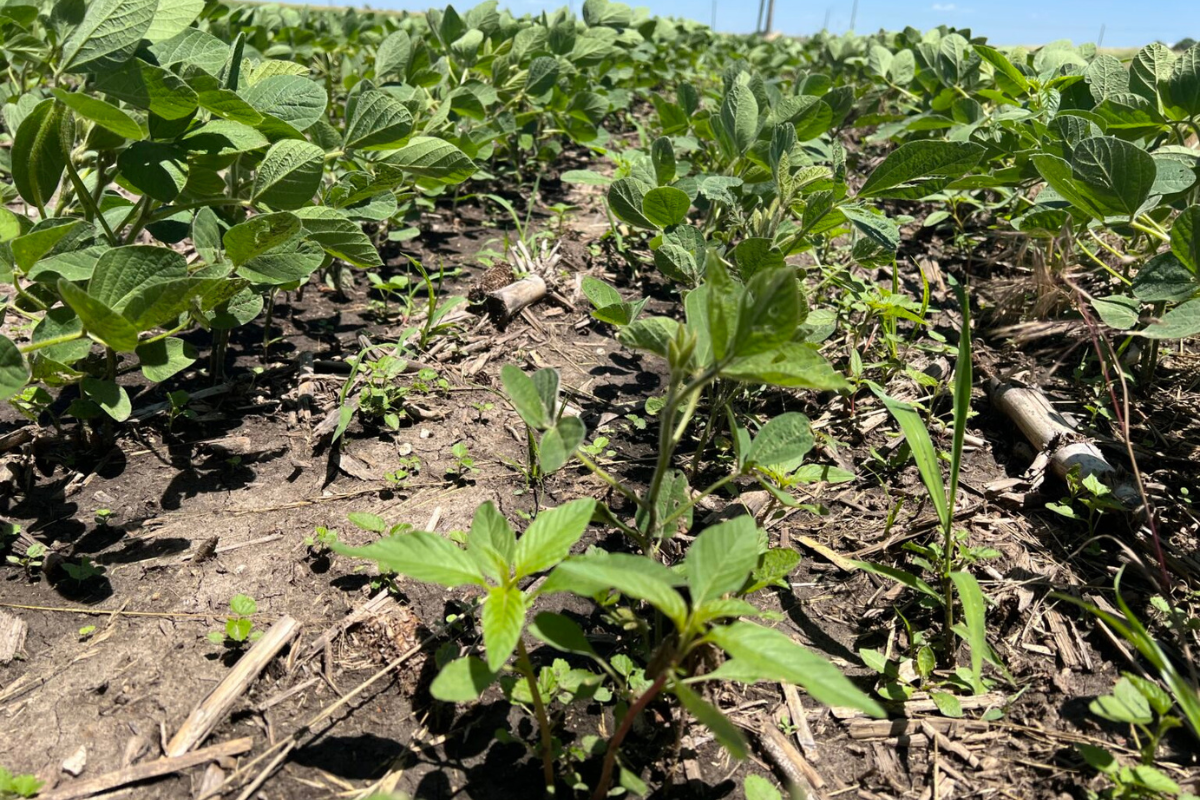
These R1 soybeans pictured on June 6, 2024, need a POST herbicide. Photo Credit: Stephanie Porter, CCA, Illinois Soybean Association
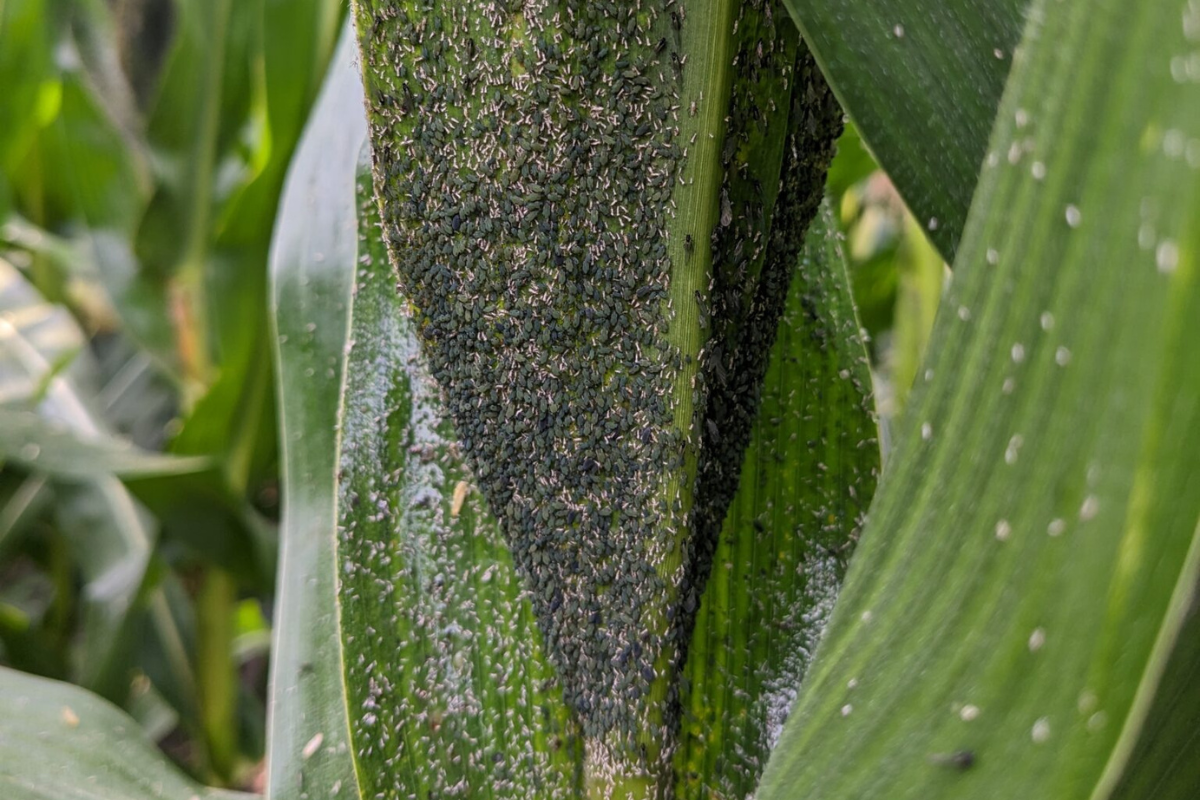
Corn lead aphid colony with winged adults (alates) in Vermilion County featured July 26, 2024, on Crop Report. Photo Credit: Talon Becker, CCA, University of Illinois Extension
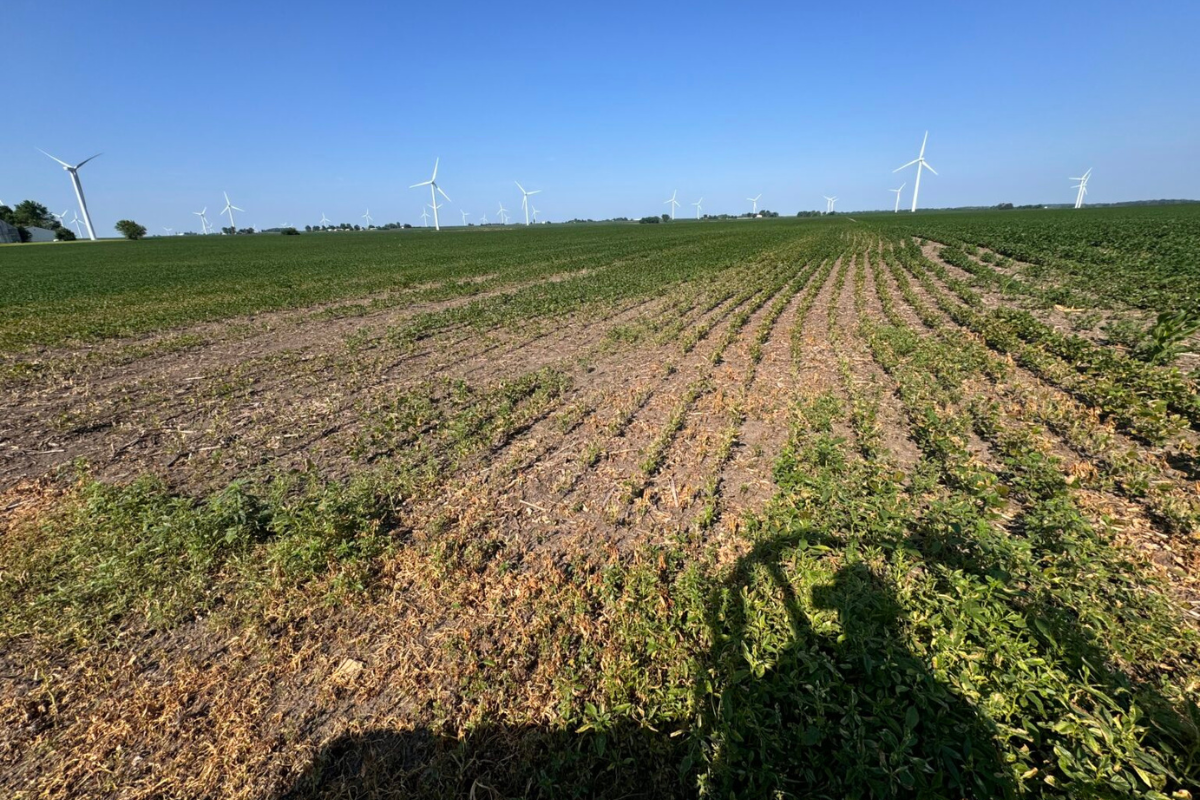
Boom flush failure resulted in a lot of switching back and forth in this field captured June 21, 2024, in Woodford County for Crop Report. Photo Credit: Karen Corrigan, CCA, MC Agronomics.
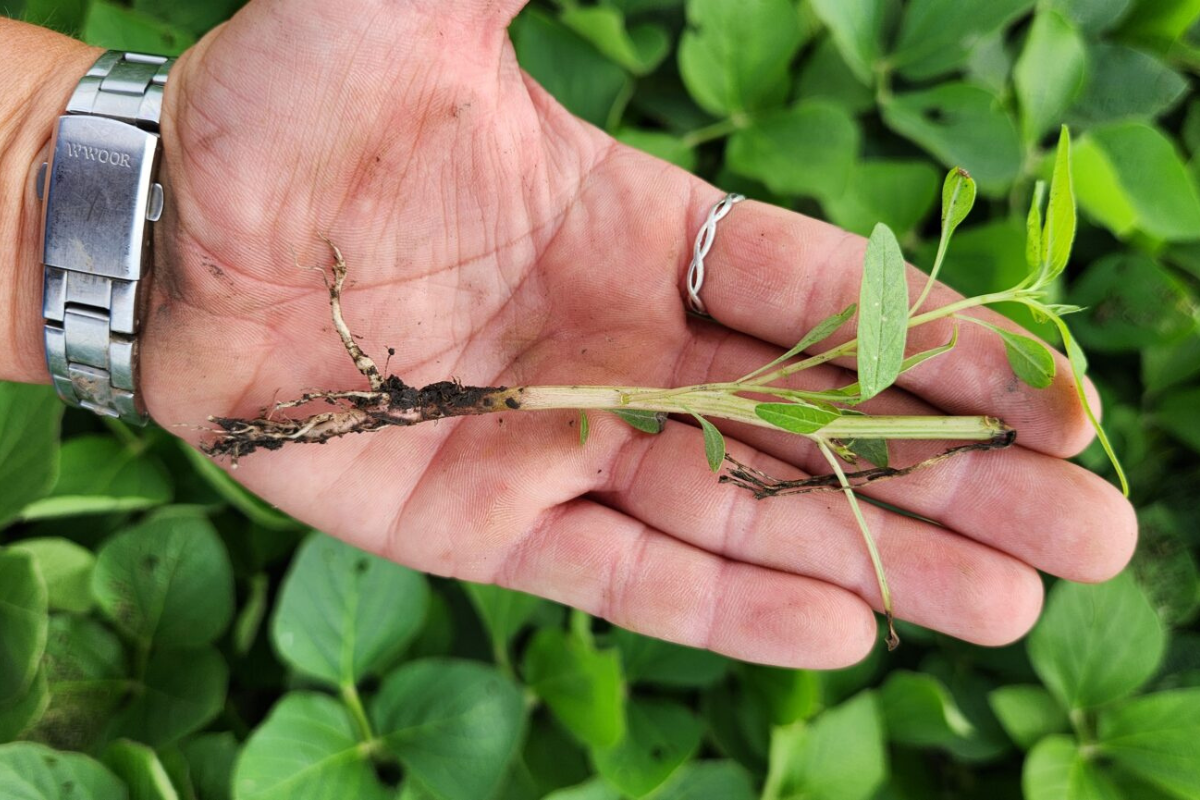
Re-growth is underway on a Champaign County waterhemp plant sprayed during dry weather three weeks before this photo was taken July 19, 2024, for Crop Report. Photo Credit: Shelby Weckel, CCA, Ehler Bros.
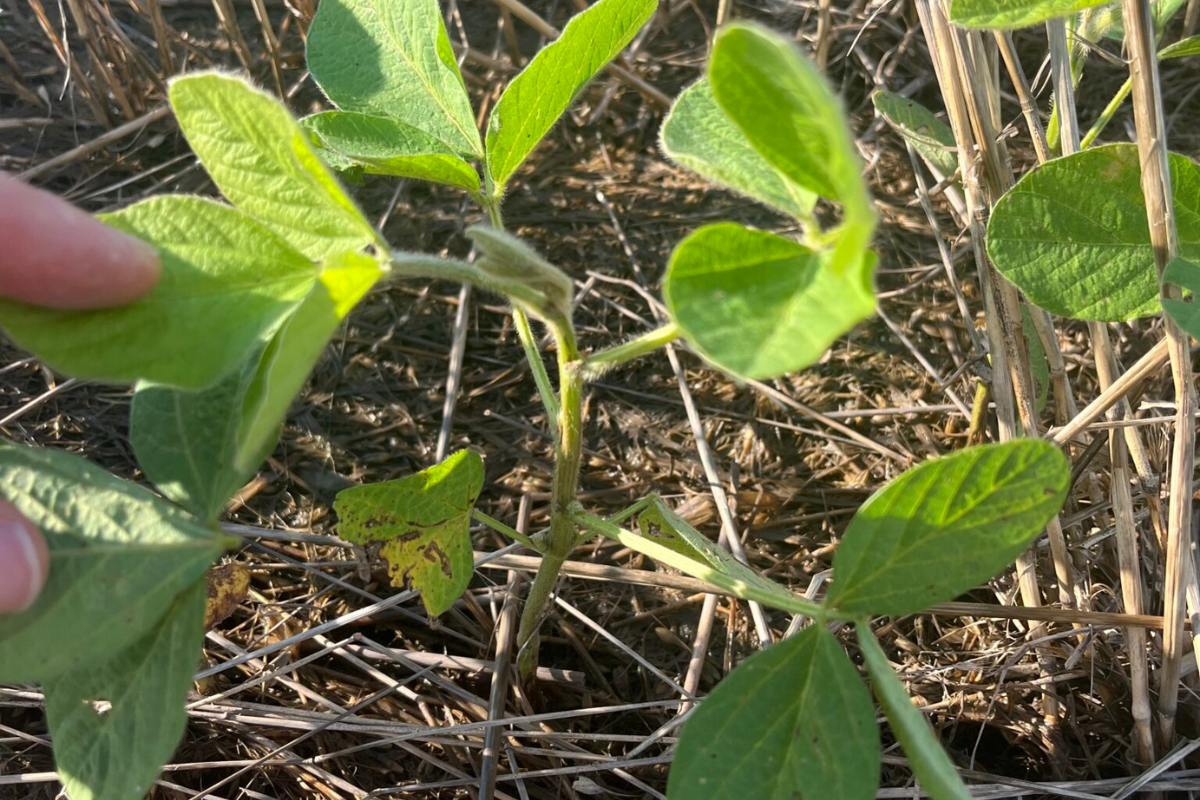
Double-crop soybeans are at V4 stage in this Crop Report photo taken July 17, 2024, in St. Clair County. Photo Credit: Dane Hunter, CCA, University of Illinois Extension.
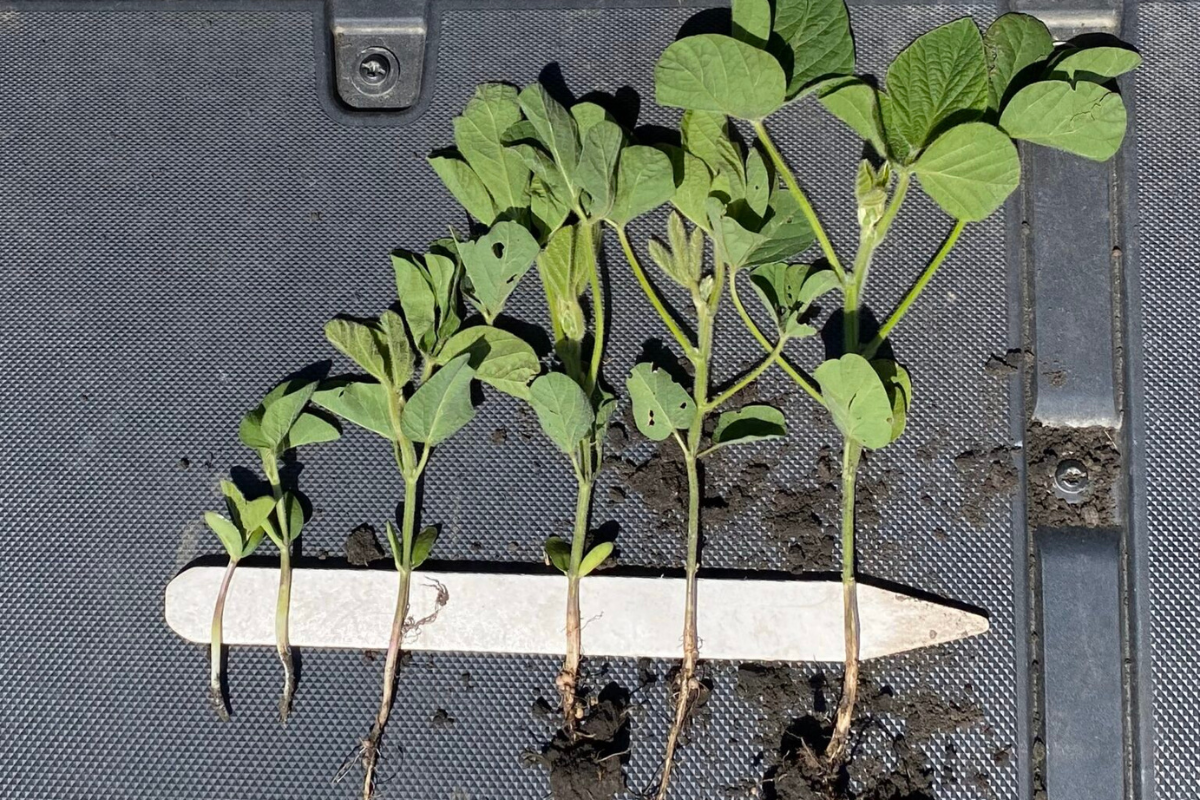
A spread of planting dates from May 30 (left) to April 24 (right) is seen June 7, 2024, in this DeKalb County image taken for Crop Report. Photo Credit: Craig Grafton, CCA, Bayer Crop Science.
What are new SOYLEIC varieties that are high-yielding and offer a value-added market opportunity?
Project Leader: Eliana Monteverde, University of Illinois
Purpose: To help farmers achieve better financial outcomes, more soybean varieties with value-added traits are needed to secure higher premiums and expand market opportunities. This research focuses on evaluating and commercializing soybean varieties with improved oil quality to create added value for growers and increase demand for soybean oil. SOYLEIC soybeans, with over 80% oleic acid and less than 3% linolenic acid (known as high oleic-low linolenic or HOLL), have oil that is more stable. This makes them a highly desirable option for food manufacturers and for industrial manufacturers producing products such as motor oil and jet fuel.
Approach: SOYLEIC varieties are developed using non-GMO breeding techniques. This project expanded the number of locations where SOYLEIC breeding lines are evaluated by the soybean improvement group at the University of Illinois. SOYLEIC varieties have been tested across 11 sites in Illinois, improving the dataset for selecting the highest-performing SOYLEIC varieties.
Results: This research provides farmers with opportunities to grow soybean varieties that earn premiums because they are non-GMO and contain the SOYLEIC trait. In 2025, there should be opportunities to grow SOYLEIC varieties on a contract basis. In future years, as the number of varieties increases, these opportunities should expand.
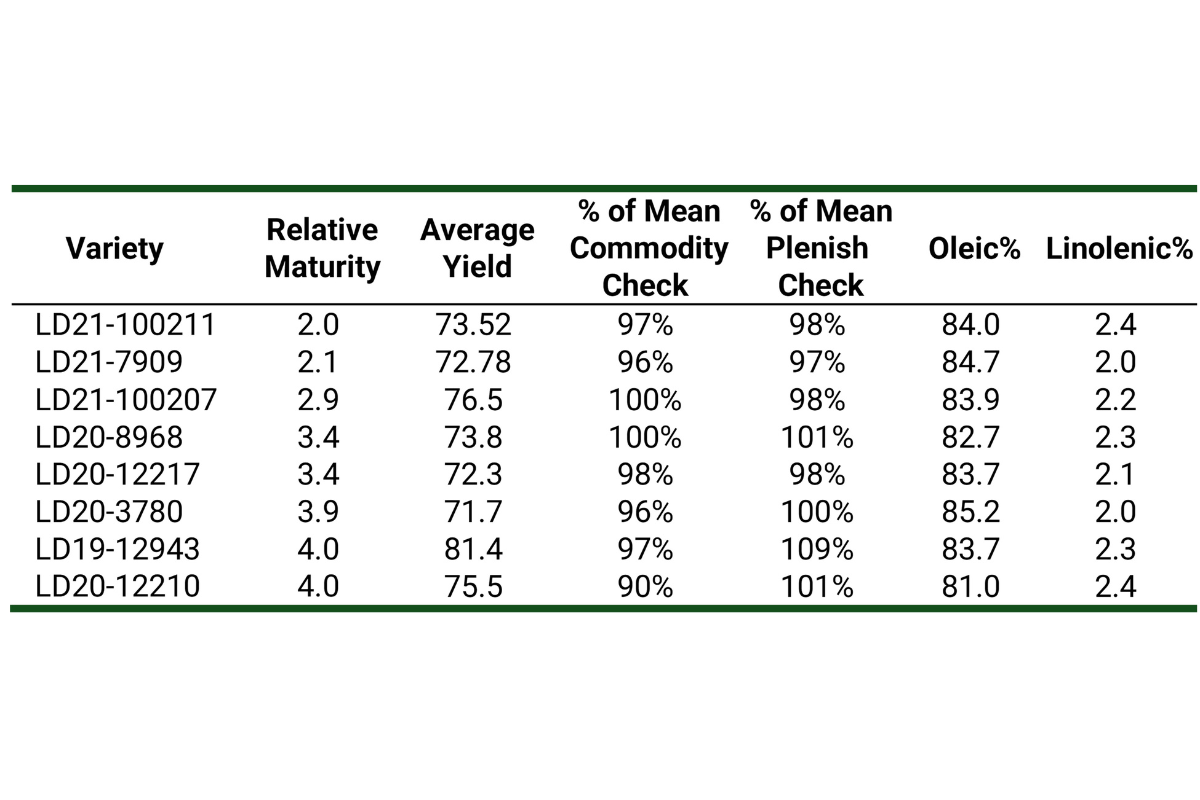
Table 1. Yield performance results from the 2023 regional trials across 10 locations compare University of Illinois lines, Corteva Plenish (Corteva’s genetically modified HOLL soybean) and Pioneer commodity checks. All SOYLEIC varieties show yields comparable to both Plenish and high-yielding Pioneer checks.
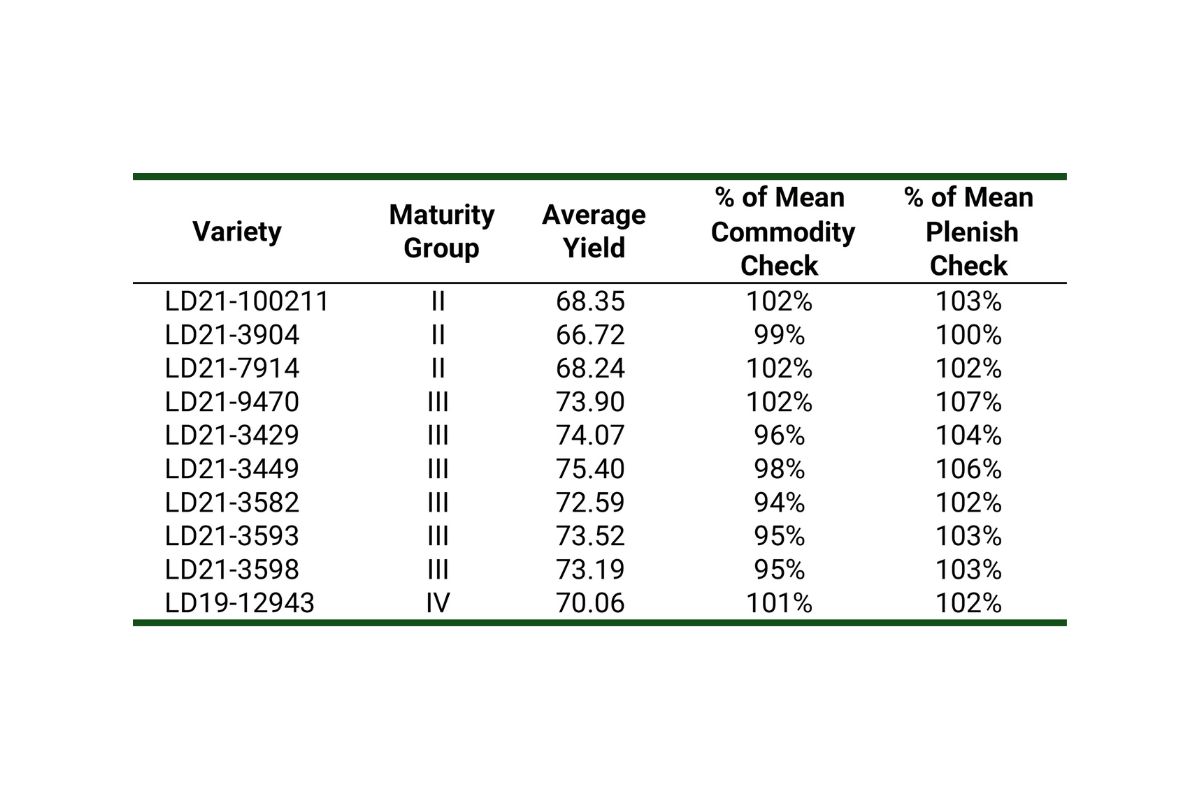
Table 2. Yield data of 2024 HOLL releases across 10 Illinois locations comparing University of Illinois lines, Corteva Plenish (Corteva’s genetically modified HOLL soybean) and Corteva conventional checks. Lines will be increased in Puerto Rico in 2025 and will be available for commercialization in 2026.
Key Takeaway: All SOYLEIC varieties show yields comparable to both Plenish and high-yielding Pioneer checks.
Which practices improve soil health, water quality and ecosystem markets for farmers?
Project Leaders: Andrew Margenot and Heidi Allen Asensio, University of Illinois
Purpose: Conservation practices, particularly those related to soil health, are seen as a way to improve farm productivity and longevity, as well as to help lessen climate change. Differences in cropping systems, growing environments and other factors make it challenging to use blanket estimates of the multiple agronomic, soil, water and climate outcomes of these practices. This research is a first step toward providing farmers, agronomists and commodity groups with an evaluation of climate-smart practices on soybean production sustainability benchmarks and water-quality improvement efforts.
Approach: Research began during the 2023 cropping season and will continue through 2026 (four full cropping seasons) at three locations across Illinois. This project studies soil health indicators, nutrient loss through leaching, soil carbon sequestration and greenhouse gas emissions response to all four possible combinations of cover cropping (cereal rye) and tillage (no-till versus chisel) practices. The research is located in three regions: southern (Ewing), central (Urbana) and northwestern (Monmouth) Illinois. A conventional corn-soybean rotation is in place at all three sites, while a double-crop wheat-soybean-corn rotation is also being studied at Ewing and Urbana. At all sites, each phase of each rotation is present each year to enable evaluation of yields of the same crop under the same rotation, cover cropping and tillage practices.
Results: Because this research project is only halfway through its final total of four cropping seasons, results shared here are preliminary. Yet after two years of data collection, some initial observations can be made:
- So far, results show that a single crop rotation (two growing seasons) isn’t enough to demonstrate effects of cover cropping or no-till on soil health and carbon credits. This is true whether the practices are used alone or together.
- Two growing seasons are enough to produce noticeable reductions in nitrate-N leaching at some sites for certain conservation practices. This suggests water quality improvements might appear more quickly than changes in soil health and carbon credits.
- Soil enzyme activity related to carbon and nitrogen acquisition appears to be the most sensitive among soil health tests so far for farmers interested in tracking early changes in soil health within two years or fewer of implementing cover crops and/or no-till (Figure 1). Soil enzyme activity was most responsive to management changes at the southern Illinois site. This means farmers with timber soils (Alfisols) and/or soils with lower soil organic matter could potentially see early responses to cover cropping and no-till.
- Results suggest that current soil health tests, in particular “active carbon” or “respiration” (also known as CO2 burst), are unlikely to detect differences in soil health after two seasons of cover cropping, tillage or crop rotation changes.
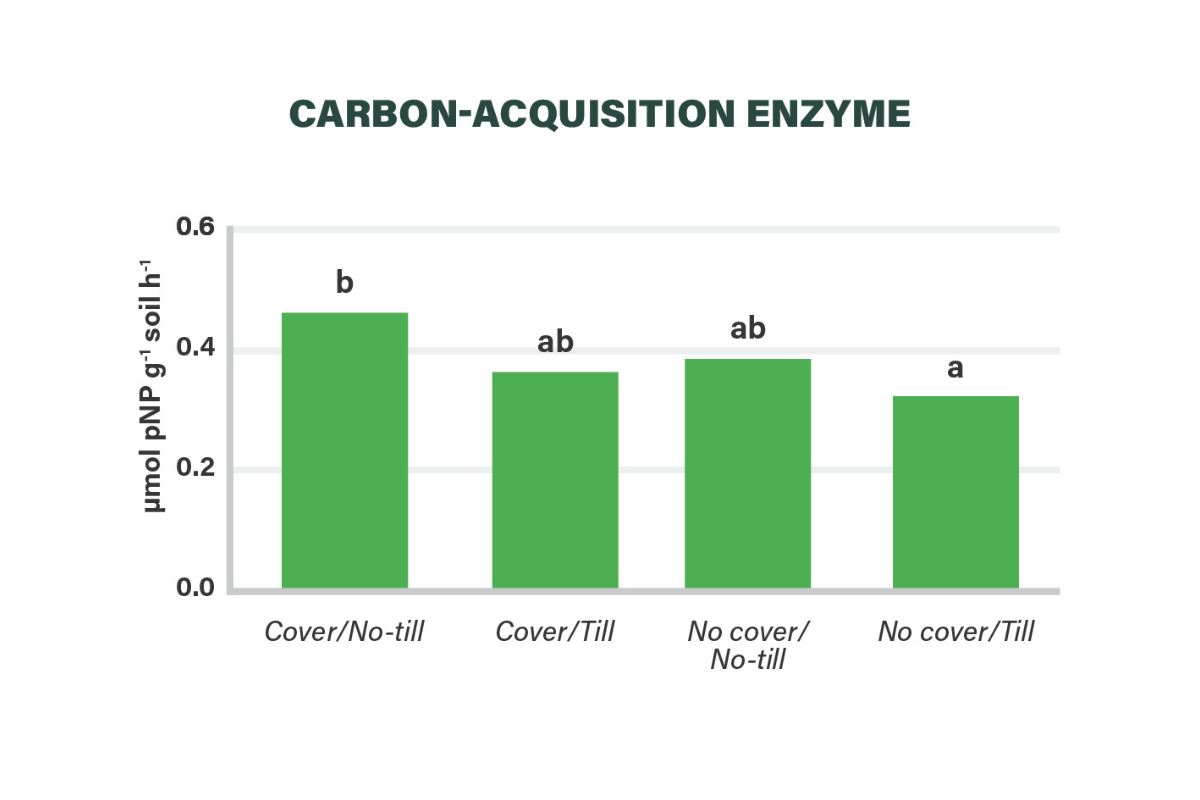
Figure 1 shows the impact of cover cropping and no-till on a carbon acquisition enzyme after only two years of the trial at Monmouth. Higher enzyme activity was found in the cover crop and no-till system, indicating increased carbon cycling compared to the tilled system without a cover crop. Treatments within the graph that share a letter are not statistically different.
Key Takeaway: Water-quality improvements might be seen more quickly than changes in soil health and carbon credits.
Which insect pests and thresholds require insecticide use or seed treatment in soybeans?
Project Leader: Nick Seiter, University of Illinois
Purpose: University recommendations typically call for a threshold-based approach to insect management, but most insecticides are either applied to the seed or based on plant growth stage. Yield trials evaluating these approaches in soybean fields often lack detailed information on present insect pest populations, creating uncertainty about whether an insecticide treatment might lead to higher yields compared to leaving the plot untreated. This multi-year research project aims to help Illinois soybean farmers determine how often insecticides protect yield and identify the insect pests responsible.
Approach: The first year of research was conducted in 2024 on four university farms in Urbana, Monmouth, Perry and Ewing. Researchers studied five treatments in soybean fields: no insecticide, insecticide seed treatment, insecticide applied at R3, insecticide applied at R5 and a combination of these three insecticide placements. Simplified versions of the experiment were also conducted on one commercial farm near Bluff City and at one community college demonstration farm in Oglesby. At these locations, a single application at R5 was evaluated (This followed an initial application at R3 across the whole field on the commercial farm). Plots were sampled for stand loss and insect damage during the early vegetative stages, and insect populations were monitored throughout the season using a sweep net.
Results: Because 2024 was the first year of a multi-year research project, farmers should be cautious about changing their practices based on the single year of data available. Economic thresholds were not exceeded for an insect pest in any of the treatments at any site. As expected, the insecticide treatments did not provide any yield protection. First-year data aligned with current insect management recommendations to scout and treat for insect pests when they exceed an economic threshold. Over time, this research will help farms of all sizes determine how often insecticides provide a positive economic return
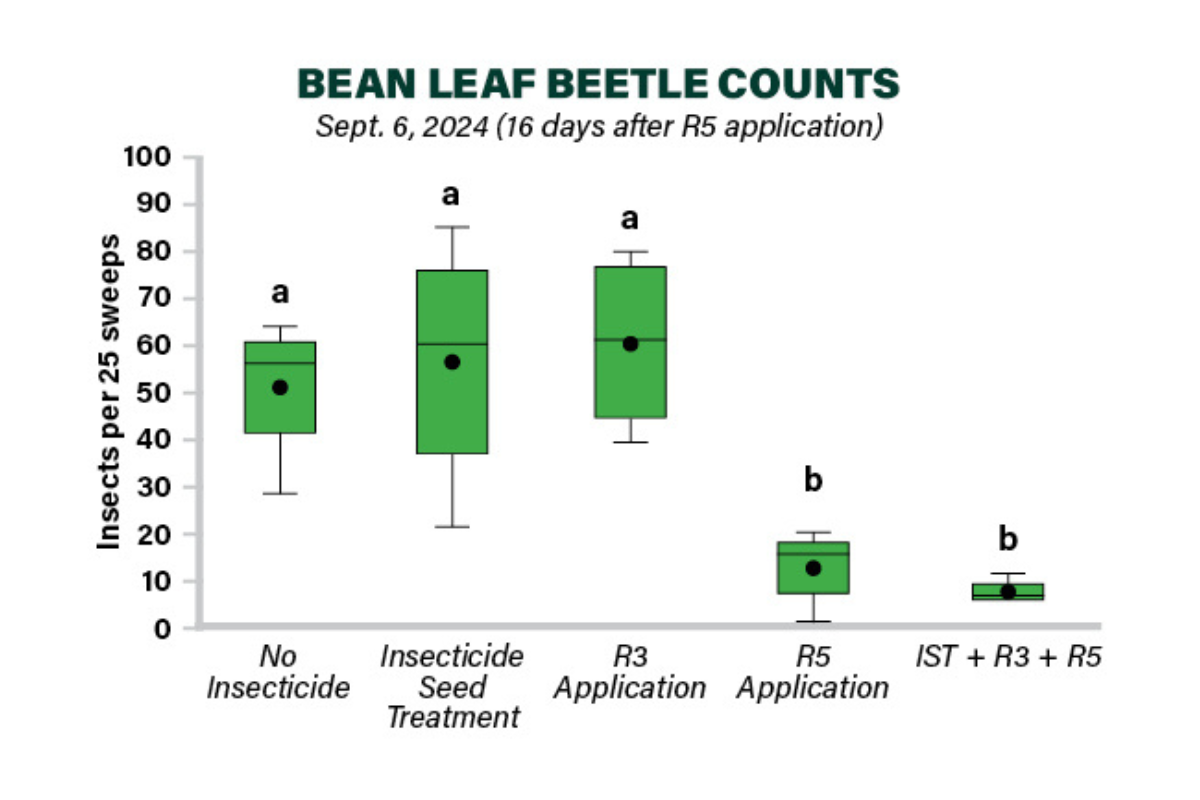
Figure 1 shows the bean leaf beetle counts for the non-treated control and the four insecticide treatments. These treatments included an insecticide seed treatment (IST), foliar insecticides at R3 and at R5, and a combination of all three (IST + R3 + R5).

Figure 2 shows there was no yield difference across the five insecticide treatments despite the R5 Application. The IST + R3 + R5 treatment showed significantly fewer bean leaf beetles than the other treatments (see Figure 1). Treatments within a graph that share a letter are not statistically different.
Which preemergence herbicides may injure early planted soybeans?
Project Leaders: Aaron Hager and Logan Miller, University of Illinois
Purpose: Early planted soybeans often face cooler and wetter conditions during emergence. In this environment, stand loss and crop injury are possible with certain preemergence (PRE) herbicides. Growers should know which commercial PRE herbicides or specific active ingredients of PRE herbicides are more likely to cause injury to soybeans and reduce yield.
Approach: Field research began in 2024 and continues for a second year in 2025. In Year 1 of the study, researchers tested 13 commercially available herbicide premixes applied at 1x labeled rates at planting. Early planting in 2024 occurred on April 15, and the conventional planting date was May 19. Additionally, sudden death syndrome (SDS)-treated (ILEVO) and non-SDS-treated soybeans were included across all PRE treatments and both planting dates. Soybean injury levels, stand counts and soybean height were all recorded at regular intervals following soybean emergence along with soybean yield.
Results:
- Soybean injury between planting dates was similar, but SDS-treated soybeans showed greater injury and stand loss regardless of PRE herbicide.
- Results from Year 1 of this project show that early-season soybean injury and stand loss can occur from PPO-based PRE herbicides regardless of planting date (sulfentrazone, flumioxazin or saflufenacil). However, Preview (sulfentrazone + metribuzin) and Prefix (fomesafen + S-metolachlor) were exceptions and did not increase soybean injury.
- Products without a PPO herbicide showed excellent crop safety compared to all other products.
- Weather during and shortly after soybean emergence remains the most important factor influencing the extent of soybean injury and stand reduction.
- In early-planted soybeans, fields that are poorly drained or prone to ponding are particularly at risk for conditions that lead to crop injury. Choosing the right herbicides in these fields can have a significant impact. Avoid using PRE herbicides that might cause injury.
- Despite injury caused by certain PRE herbicides, all treatments recovered from injury by 28 days after emergence, and stand counts were overall greater than 100,000 plants per acre.
- Individual PRE herbicides did not negatively affect soybean yield. Stand loss from the addition of ILEVO seed treatment is likely what resulted in a 5- to 6-bushels-per-acre soybean yield reduction for both planting dates.
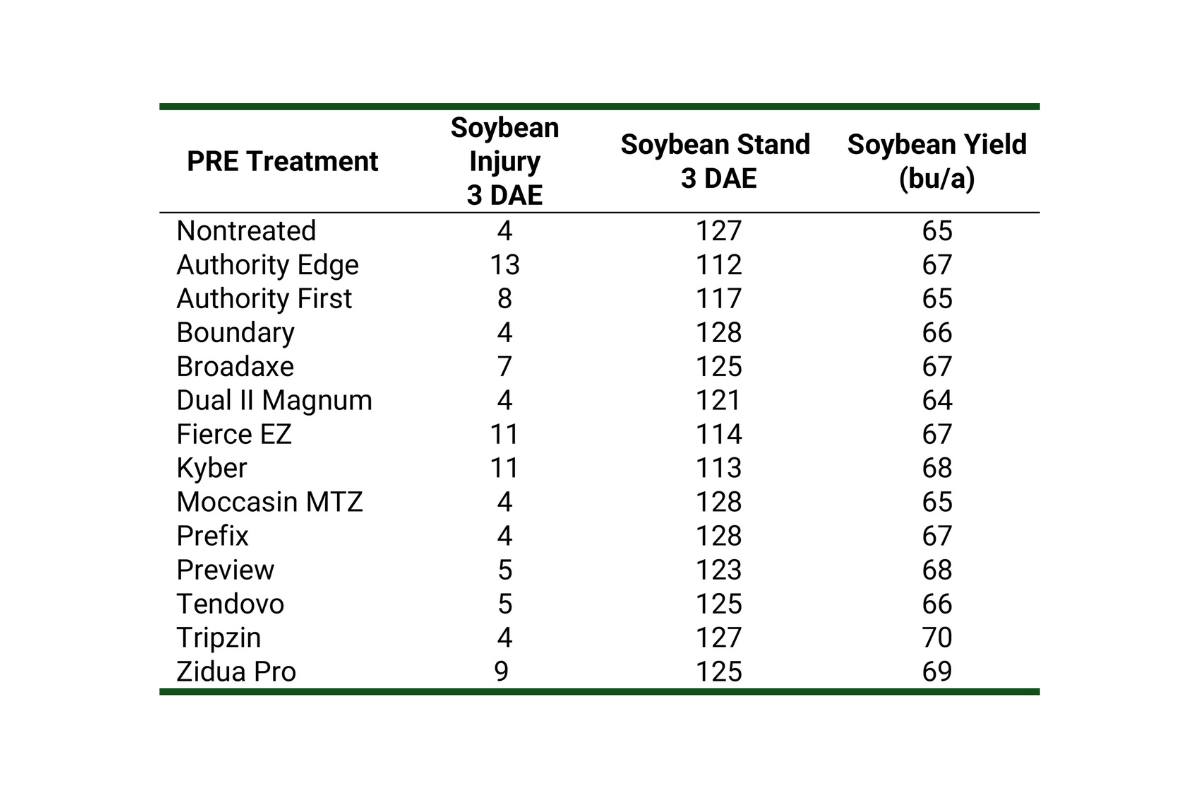
Table 1. Soybean Response to PRE Herbicide
PRE herbicide impact was evaluated by soybean injury (0–100 scale) and stand count (1,000 plants/acre) three days after emergence. Injury varied by treatment, but final yields did not differ.
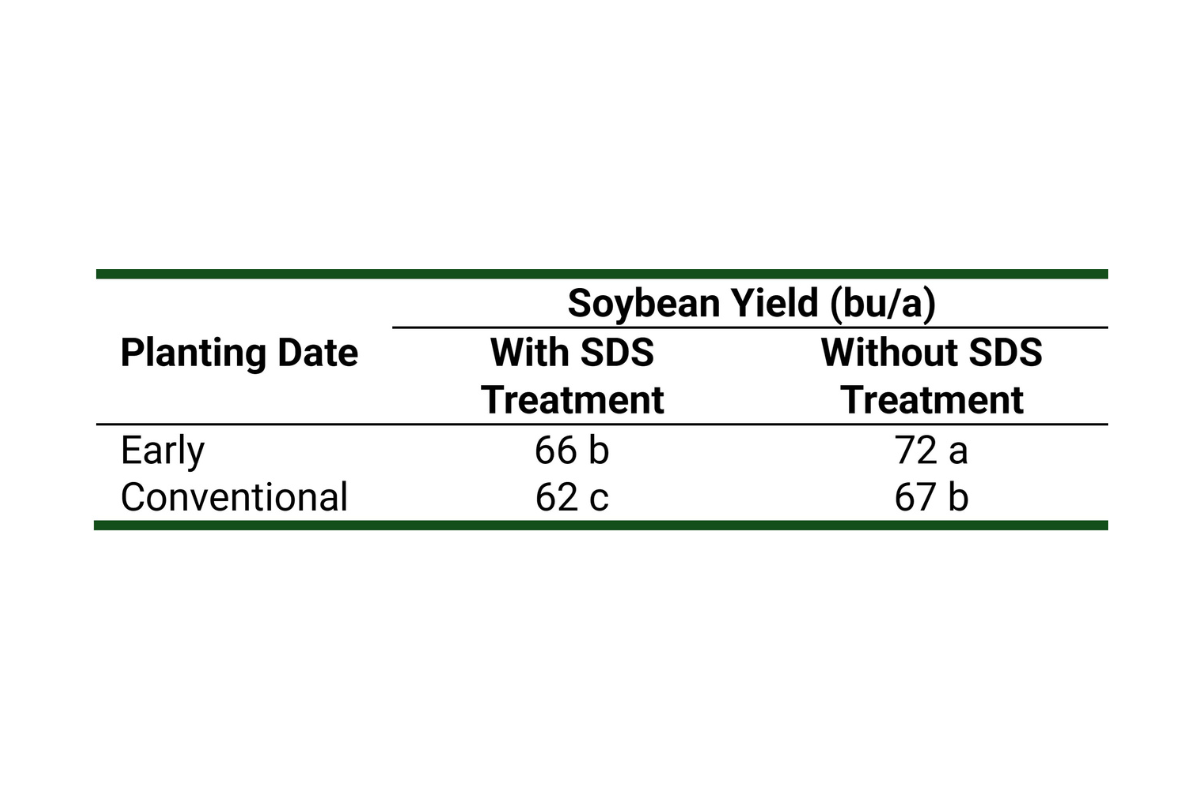
Table 2. Soybean Yield
ILEVO soybeans treated for SDS yielded 5 to 6 bushels per acre less than non-SDS-treated soybeans at both planting dates. Treatments within the table that share a letter are not statistically different.
Key Takeaway: Certain PRE herbicides do cause early-season soybean injury but might not impact yield.
Which wheat varieties tolerate spring freezes and enable earlier harvest for timely double-crop soybeans?
Project Leader: Jessica Rutkoski, University of Illinois
Purpose: For each day wheat is harvested earlier, double-crop soybeans gain about 0.5 bushels per acre on average. Farmers need access to elite early wheat varieties that yield well and avoid early jointing when freeze events could damage reproductive growth. This research helps farmers choose the right wheat varieties to maximize wheat yields and plant double-crop soybeans earlier. Earlier double-crop soybean planting can lead to higher soybean yields, ultimately improving economic returns on wheat and double-crop soybean acres.
Approach: In 2024, researchers grew and collected yield data on commercial wheat varieties at multiple locations. At two sites, Urbana and St. Peter, they also measured jointing and maturity. Jointing marked the start of reproductive growth, while physiological maturity and 14% moisture indicated harvest maturity date. Full data on commercial varieties was reported in the University of Illinois Official Variety Trial publication, available at vt.cropsci.illinois.edu. This research continues for a second year in 2025.
Results:
- There was a nine-day range in maturity dates among commercial wheat varieties. Takeaway: Selecting the right wheat variety can help growers plant their double-crop soybeans about one week earlier.
- In southern Illinois, early jointing was linked to lower yields. Jointing time accounted for 15% of yield variation among varieties. Takeaway: Early jointing wheat varieties should generally be avoided in our region. Select early maturing varieties that do not joint early.
- Earlier-maturing varieties had slightly higher test weights than later-maturing varieties. Scab resistance had a much larger impact on test weight but was not linked to maturity timing. Takeaway: Earlier-maturing wheat varieties might have a slight test weight advantage, but scab resistance plays a much larger role in determining test weight.
- Jointing time is partially controlled by the same genes that determine the duration of winter and day length needed to trigger the onset of the reproductive growth phase. Takeaway: Jointing time is genetically controlled, so varieties that do not joint early in your area should always be expected to follow a similar pattern.
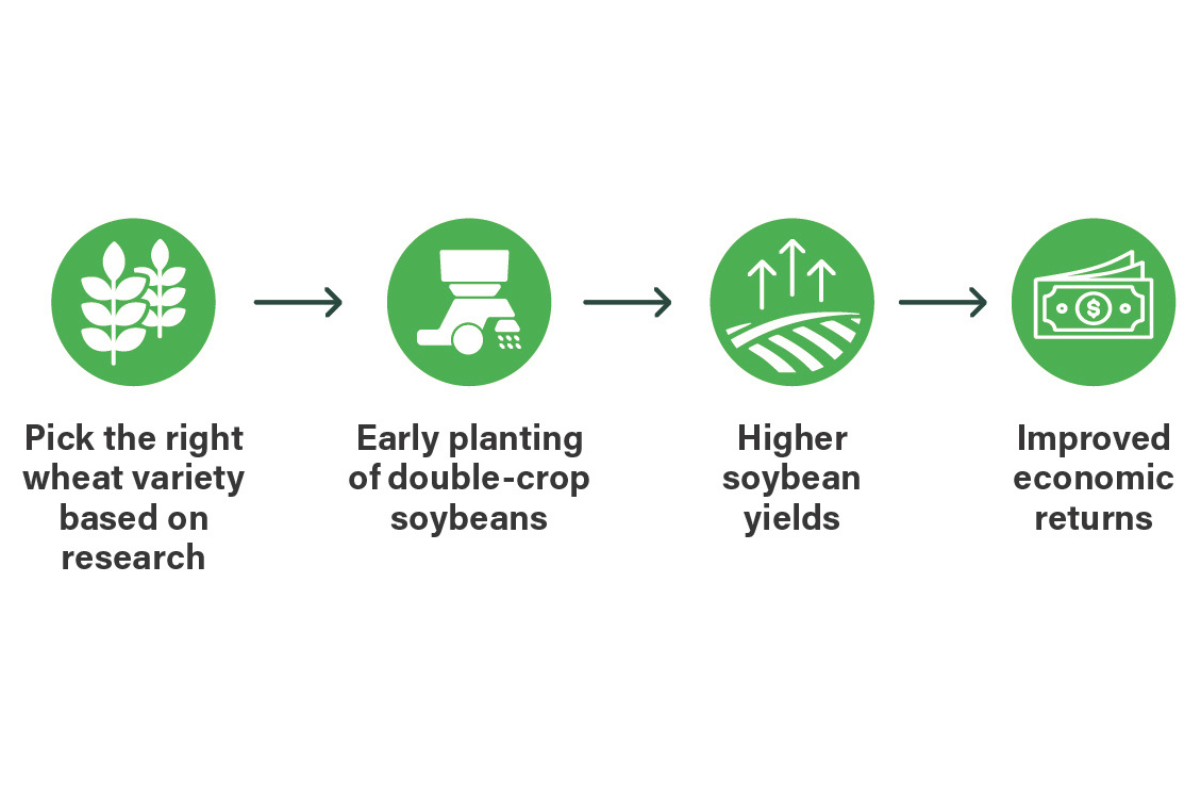
Recent Articles
See how ISA is driving innovation in soybean production by investing in farmer-led research and equipping growers with tools for the future.
By
What's in store for farmers in 2026? Illinois Field & Bean sits down with some of Illinois Soybean Association’s Corporate Partners to find out what they’re anticipating in the new year.
By Ashley Rice-Haddon, Illinois Field & Bean Magazine, Lead Writer
